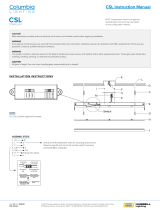CSG
70
GAS SUPPLY-CSG
RIGHT
MINIMUM PULL of equipment away from
wall permissible for accessibility to
Quick Disconnect Device
WRONG
AVOID SHARP BENDS AND KINKS when
pulling equipment away from wall. (Maximum
pull will kink ends, even if installed properly,
and reduce Connector life.)
Couplings and hose should be installed in
the same plane as shown at left. DO NOT
OFFSET COUPLINGS – this causes torsional
twisting and undue strain causing premature
failure.
This is the correct way to install metal hose
for vertical travers. Note the single, natural
loop.
Allowing a sharp bend, as shown at right,
strains and twists the metal hose to a point of
early failure at the coupling.
Maintain the minimum or larger bending
diameter between the couplings for longest
life.
Closing in the diameter at the couplings, as
shown at right, creates double bends causing
work fatigue failure of the fittings.
In all installations where “self-draining” is not
necessary, connect metal hose in a vertical
loop.
DO NOT CONNECT METAL HOSE
HORIZONTALLY...unless “self-draining”
is necessary then use support on lower plane
as shown at left.
CABLE RESTRAINT
Please refer to the illustration below when
installing cable restraint on all moveable units.
I-bolt is to be secured to the building using
acceptable building construction practices.
DRYWALL CONSTRUCTION
Secure I-bolt to a building stud.
DO NOT attach to drywall only. Also,
locate the I-bolt at the same height as
the gas service. Preferred installation is
approximately six inches to either side
of service. Cable restraint must be at
least six inches shorter than flexible
gas line.
Utilize elbows when necessary to avoid
sharp kinks or excessive bending. For
ease of movement, install with a “lazy”
loop. Gas appliance must be discon-
nected prior to maximum movement.
(Minimum movement is permissible for
hose disconnection.)











